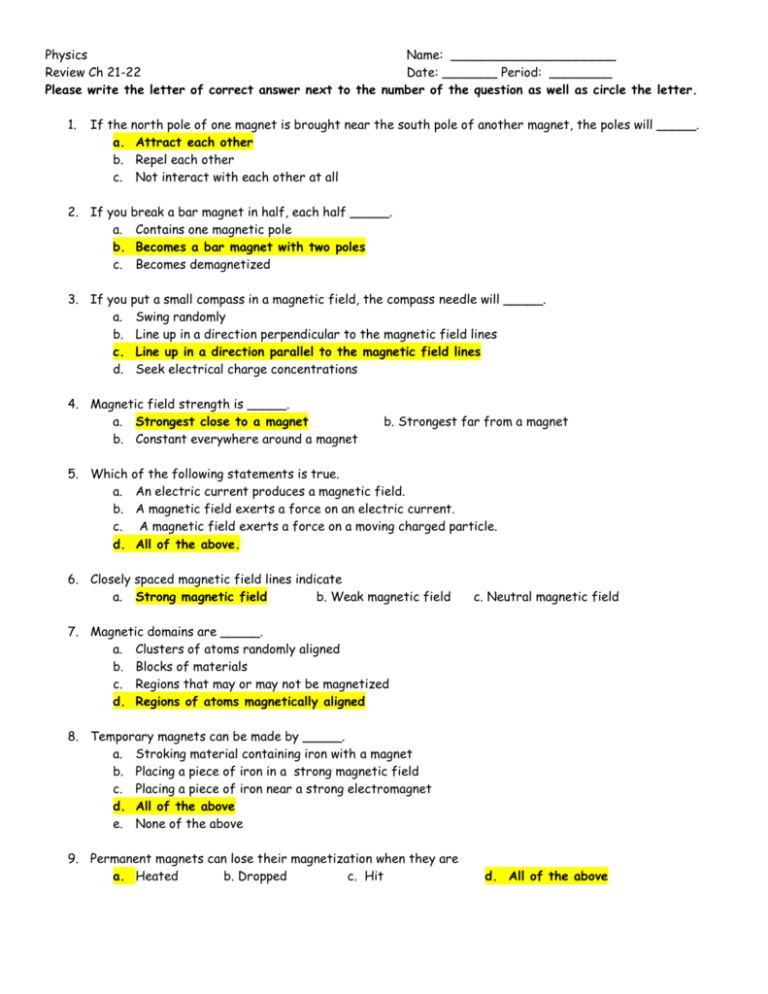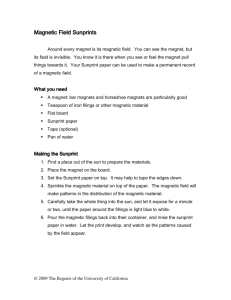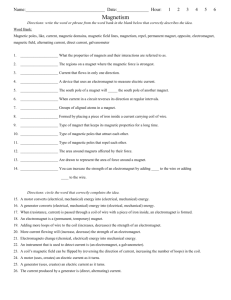Magnetism review key
advertisement

Physics Name: _____________________ Review Ch 21-22 Date: _______ Period: ________ Please write the letter of correct answer next to the number of the question as well as circle the letter. 1. If the north pole of one magnet is brought near the south pole of another magnet, the poles will _____. a. Attract each other b. Repel each other c. Not interact with each other at all 2. If you a. b. c. break a bar magnet in half, each half _____. Contains one magnetic pole Becomes a bar magnet with two poles Becomes demagnetized 3. If you a. b. c. d. put a small compass in a magnetic field, the compass needle will _____. Swing randomly Line up in a direction perpendicular to the magnetic field lines Line up in a direction parallel to the magnetic field lines Seek electrical charge concentrations 4. Magnetic field strength is _____. a. Strongest close to a magnet b. Constant everywhere around a magnet 5. Which a. b. c. d. b. Strongest far from a magnet of the following statements is true. An electric current produces a magnetic field. A magnetic field exerts a force on an electric current. A magnetic field exerts a force on a moving charged particle. All of the above. 6. Closely spaced magnetic field lines indicate a. Strong magnetic field b. Weak magnetic field c. Neutral magnetic field 7. Magnetic domains are _____. a. Clusters of atoms randomly aligned b. Blocks of materials c. Regions that may or may not be magnetized d. Regions of atoms magnetically aligned 8. Temporary magnets can be made by _____. a. Stroking material containing iron with a magnet b. Placing a piece of iron in a strong magnetic field c. Placing a piece of iron near a strong electromagnet d. All of the above e. None of the above 9. Permanent magnets can lose their magnetization when they are a. Heated b. Dropped c. Hit d. All of the above 10. The reason a magnet can attract an unmagnetized nail is that _____. a. Nails become permanently magnetized in a magnetic field. b. Nails become temporarily magnetized in a magnetic field c. Nails are really magnetized d, A magnet cannot attract anything that is not also magnetized. 11. When current flows through a straight wire, a magnetic field is created that can be drawn as_____. a. straight lines perpendicular to the wire b. concentric circular loops around the wire c. straight lines parallel to the wire d. closed loops parallel to the wire 12. In order to make an electromagnet, you need a _____.(D is most correct, but we have/will always use a nail) a. Battery, some wire, and a nail b. Battery, a nail, and a magnet c. Magnet, a nail, and some wires d. Loop of wire, contacts and a battery (Nails just make it stronger). e. None of the above 13. The magnetic pole in the Northern Hemisphere is located _____. a. In Alaska b. In Canada c. Just north of the United States d. None of the above 14. Which geographic pole of the earth is nearest the magnetic north pole of the earth? a. North pole b. South pole c. both a and b 15. If a compass is suddenly moved from the Northern Hemisphere to the Southern Hemisphere, the direction its magnetic needle points will _____. a. Change direction by 180 degrees b. Not change at all c. Change direction by 90 degrees d. None of the above 16. Magnetic field lines surrounding a magnet are conventionally drawn _____. a. From north pole to south pole b. From south pole to north pole c. Either way 17. Electric current can be induced in a coil of wire by _____. a. Moving the axis of the coil up and down along the length of the magnet b. Holding the coil very still next to a magnet c. Moving a magnet up and down along the axis of the coil d. Rotating the wire in a external magnetic field e. a, c, and d are all correct 18. A magnet is moved in and out of a coil of wire connected to a high resistance voltmeter. If the number of coils doubles, the induced voltage and current _____. a. Quadruple b. Double c. stay the same b. Halve e. None of the above 19. The phenomenon of inducing voltage and current by changing the magnetic field around a conductor is called _____. a. Generated voltage b. Electromagnetic radiation c. Transformer induction d. Electromagnetic induction 20. A device that uses two coils around an iron core to change the voltage across a circuit is called a ____. a. Voltmeter b. Diode c. Transformer d. Generator e. Motor 21. Which of the following devices would have an increase in voltage _____. a. Generator b. step down transformer c. step up transformer d. permanent magnet 22. What type of device converts electric energy into mechanical energy? a. generator b. motor c. electromagnet d. transformer 23. The primary coil to a transformer has 1000 turns is connected to a 120 V source. What number of turns in the secondary will produce 12 V? V2 = n2 V1 = n 1 12 120 = __n2_ 1000 n2 = 100 turns 24. A step up transformer has 100 turns on its primary and 500 turns on its secondary. When the primary is supplied with an alternating current at 120 V, what is the voltage across the secondary? V2 = n2 V1 = n 1 V2 120 = __500_ V2 = 600 turns 100 25. Where is magnetic force strongest on a bar magnet? a. in the middle b. at the poles c. anywhere 26. Electron current can best be induced in a wire by a. stretching the wire b. moving a magnet up and down near the wire. c. setting the wire near a magnet d. rotating the wire 27. A device that uses two coils around an iron core to change the voltage across a circuit is called a a. voltmeter b. motor c. transformer d. generator e. diode 28. The primary coil of a transformer has 100 turns on it and the secondary coil has 50 turns on it. This is a. a step down transformer b. a step up transformer c. either of the above, depending on relative input and output currents. 29. An iron rod becomes magnetic when a. positive charges line up on one side and negative charge on the other side. b. positive ions gather at one end and negative ions at the other end. c. its electron stop moving and point in the same direction d. the net spins of its electrons point in the same direction e. none of the above 30. Surrounding every moving electron is a. an electric field b. a magnetic field c. both A and B d. none of the above 31. If you put a small compass in a magnetic field, the compass will a. line up in the direction parallel to magnetic field lines b. swing randomly c. line up in a direction perpendicular to the magnetic field lines. d. seek electrical charge connections 32. Magnetic field strength is a. strongest close to a magnet. c. strongest far from a magnet. 33. Magnetic fields are produced by a. moving particles of Earth d. moving charged particles b. constant everywhere around the magnet. b. charges at rest e. none of above 34. Magnetic domains are a. regions that may or may not be magnetized c. regions of atoms magnetically aligned c. moving particles b. cluster of all atoms randomly aligned d. block of material 35. Changing the magnetic field intensity in a closed loop of wires induces a. current b. voltage c. both current and voltage d. neither current nor voltage 36. A device consisting of a coil that is mechanically rotated in a stationary magnetic field is called a a. motor b. a magnetic pole c. a generator d. a transformer 37. A generator is used to light a bulb. Energy for the lighting the bulb actually comes from a. a plug where the generator is connected to the wall. b. a mechanical input to the generator. c. the magnet in the generator. d. the coil of wire. 38. The source of all magnetism is a. moving electrical charges c. tiny pieces of iron b. ferromagnetic materials d. tiny domain of aligned atoms 39. Moving electrical charges will interact with a. an electrical field b. a magnetic field c. Both A and B d. none of the above 40. Surrounding every moving electron is a. an electric field c. Both A and B b. a magnetic field d. none of the above 41. Earth’s magnetic field is most likely due to a. millions of small magnets buried in the Earth b. a magnetized solid inner core of Earth c. convection currents in the molten part of the Earth’s interior. d. the rotation of Earth acting on all of Earth’s electrons 42. The voltage across a transformer primary coil that has 50 turns is 25 V. What is voltage across the secondary coil, which has 20 turns. a. 2V b. 10 V c. 20 V d. 40 V e. 50 V







